Potrebujeme váš súhlas na využitie jednotlivých dát, aby sa vám okrem iného mohli ukazovať informácie týkajúce sa vašich záujmov. Súhlas udelíte kliknutím na tlačidlo „OK“.
ASTM E328-13
Standard Test Methods for Stress Relaxation Tests for Materials and Structures
Automaticky preložený názov:
Štandardných testovacích metód, relaxácia napätia skúšky materiálov a štruktúr
NORMA vydaná dňa 1.11.2013
Informácie o norme:
Označenie normy: ASTM E328-13
Poznámka: NEPLATNÁ
Dátum vydania normy: 1.11.2013
Kód tovaru: NS-46419
Počet strán: 15
Približná hmotnosť: 45 g (0.10 libier)
Krajina: Americká technická norma
Kategória: Technické normy ASTM
Kategórie - podobné normy:
Anotácia textu normy ASTM E328-13 :
Keywords:
bending relaxation, bolting, compression relaxation, hoop stresses, riveting, springs, stress relaxation, tension relaxation, torsion relaxation, ICS Number Code 19.020 (Test conditions and procedures in general)
Doplňujúce informácie
| Significance and Use | ||||||||||||||||
|
5.1 Relaxation test data are necessary when designing most mechanically fastened joints to assure the permanent tightness of bolted or riveted assemblies, press or shrink-fit components, rolled-in tubes, etc. Other applications include predicting the decrease in the tightness of gaskets, in the hoop stress of solderless wrapped connections, in the constraining force of springs, and the stability of wire tendons in prestressed concrete. 5.2 The ability of a material to relax at high-stress concentrations such as are present at notches, inclusions, cracks, holes, fillets, etc., may be predicted from stress relaxation data. Such test data are also useful to judge the heat-treatment condition necessary for the thermal relief of residual internal stresses in forgings, castings, weldments, machined or cold-worked surfaces, etc. The tests outlined in these methods are limited to conditions of approximately constant constraint and environment. 5.3 The general stress relaxation test is performed by isothermally applying a force to a specimen with fixed value of constraint. The constraint is maintained constant, and the constraining force is determined as a function of time. The major problem in the stress relaxation test is that constant constraint can be very difficult to maintain. The effects on test results are very significant, and considerable attention must be given to minimize the constraint variation. Also, experimenters should determine and report the extent of variation in each stress relaxation test so that this factor can be taken into consideration. 5.4 There are many methods of performing the stress relaxation test, each with a different starting procedure. However, the constraint is usually obtained initially by the application of an external force at either a specific force application rate or a specific strain rate. The two methods will produce the characteristic behavior shown in 5.5 The stress relaxation test is considered to have started at zero time, t0 in 1.1 These test methods cover the determination of the time dependence of stress (stress relaxation) in materials and structures under conditions of approximately constant constraint, constant environment, and negligible vibration. In the procedures recommended, the material or structure is initially constrained by externally applied forces, and the change in the external force necessary to maintain this constraint is determined as a function of time. 1.2 Specific methods for conducting stress relaxation tests on materials subjected to tension, compression, bending and torsion stresses are described in Parts A, B, C, and D, respectively. These test methods also include recommendations for the necessary testing equipment and for the analysis of the test data. 1.3 It is recognized that the long time periods required for these types of tests are often unsuited for routine testing or for specification in the purchase of material. However, these tests are valuable tools in obtaining practical design information on the stress relaxation of materials subjected to the conditions enumerated, and in investigations of the fundamental behavior of materials. 1.4 Units—The values stated in inch-pound units are to be regarded as standard. The values given in parentheses are mathematical conversions to SI units that are provided for information only and are not considered standard. 1.5 This standard does not purport to address all of the safety concerns, if any, associated with its use. It is the responsibility of the user of this standard to establish appropriate safety and health practices and determine the applicability of regulatory limitations prior to use. |
||||||||||||||||
| 2. Referenced Documents | ||||||||||||||||
|
Podobné normy:
Historická
1.9.2013
Historická
1.4.2013
Historická
1.8.2013
Historická
1.3.2013
Historická
1.4.2014
Historická
1.1.2009
Odporúčame:
Aktualizácia technických noriem
Chcete mať istotu, že používate len platné technické normy?
Ponúkame Vám riešenie, ktoré Vám zaistí mesačný prehľad o aktuálnosti noriem, ktoré používate.
Chcete vedieť viac informácií ? Pozrite sa na túto stránku.


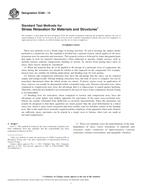
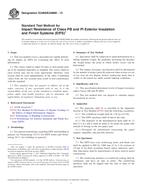 ASTM E2486/E2486M-13..
ASTM E2486/E2486M-13..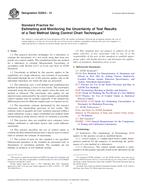 ASTM E2554-13
ASTM E2554-13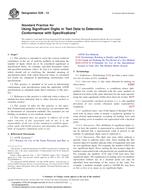 ASTM E29-13
ASTM E29-13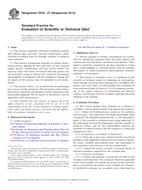 ASTM E678-07(2013)..
ASTM E678-07(2013)..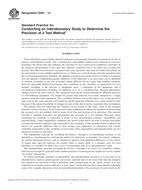 ASTM E691-14
ASTM E691-14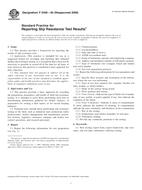 ASTM F2048-00(2009)..
ASTM F2048-00(2009)..
 Cookies
Cookies
